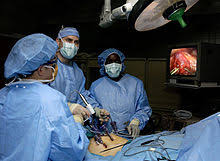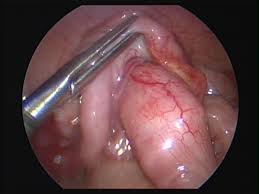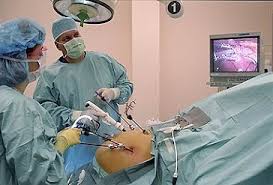Laparoscopic surgery, also called as laser surgery by layman. It is also referred as Minimally Invasive Surgery (MIS), Band aid Surgery, Keyhole Surgery. It is a modern surgical technique in which operations in the abdomen are performed through small incisions (usually 0.5–1.5 cm) as compared to the larger incisions needed in laparotomy (open surgery).
Images displayed on TV monitors for magnification of the surgical elements. Surgeries are conducted with more precision as camera gives clear and precise picture as though looking at a organ in real life.
Advantages of Laparoscopic Surgery
When compared to open surgeries, laparoscopic procedures offer a number of advantages to the patients. These include (among others)-
1 .Reduced blood loss, which reduces the chance of needing a blood transfusion.
2. Reduced exposure of internal organs to possible external contaminants thereby reduced risk of acquiring infections.
3. Smaller incisions, which reduce pain and shorten recovery time, as well as result in less post-operative scarring.
4. Although procedure times are usually slightly longer, hospital stay is less, and often with a same-day discharge which leads to a faster return to normal life.
5. Less pain, requiring less pain medication.
6. Single Incision (scarless) surgery thru' Umbilicus
7 Early resume to work.
8 Cosmetically very good as there are invisible scars
9 Safer as because of magnified vision
Surgical Facilities Available
1) Laparoscopic Bariatric (Obesity) Surgery
- Mini Gastric Bypass(MGB)
- Gastric Bypass(RYGB)
- Sleeve Gastrectomy
- Lapaparoscopic Banding.
- Balloon
2) Laparoscopic General Surgery
- Laparoscopic Hernia Repair (Incisional Inguinal, Umbilical)
- Laparoscopic surgery for appendix- Appendectomy
- Laparoscopicsurgery for galbllader stone.- Cholecystectomy
- Heller's Myotomy
- Laparoscopic Fundoplication-For heart burn/acidity
- Laparoscopic Duodenal Perforation Repair
- Laparoscopic Spleenectomy
- Laparoscopic Adhesiolysis
-Laparoscopic hydatid cyst excision
- Laparoscopic Mesenteric Lymph Node Biopsy
- Spleenectomy
3)Laparoscopic Gynaecological Surgery
- Lap Hysterectomy
-Laparoscopic werthiems hysterectomy for cancer uterus
-Lap mymectomy
- Lap Ovarian Cyst Excision
- Lap Tubectomy
- Lap Reversal of Tubectomy
4) Laparoscopic Colorectal Surgery
- Laparoscopic Posterior Mesh Rectopexy for prolapse
-Laparoscopic Abdomino
- Perineal Resection
- laparoscopic Colostomy
5) Laparoscopic cancer surgery
Laparoscopic Colectomy for colon cancer
Laparoscopic Anterior Resection for rectal cancer
Laparoscopic oesophageal cancer surgery
Laparoscopic gastric cancer surgery
6) Endoscopic Urological Surgery
- Laparoscopic Nephrectomy
- Laparoscopic operation for undescended testis
- Laparoscopic operation for Varicocele
7) Thoracoscopy
- Thoracoscopic decortications
- Thoracoscopic pnumectomy
Working Experience
Practicing in Nagpur since 1997 i.e since 20 years
Ex associate professor Govt medical college Nagpur
Since 20 years he is performing surgeries with consistently good results Have wide experience in handling complicated cases of GI Surgeries and abdominal trauma
Diploma in laparoscopic surgeries
20 years of experience in performing simple and complicated laparoscopic surgeries
Certificate training from FAPI :- Fellowship of family planning association of India
FAIS :- Fellowship of association of Indian surgeons
FIAGES:- Fellowship of Indian Association of gastrointestinal surgeons
FAMS:- Fellowship of association of minimal invasive surgeons
Laparoscopic Appendicectomy
1) What is Appendix?
The appendix is the narrow small finger shaped portion of large intestine, it generally hangs down from the lower right side of abdomen where small intestine joins the large intestine. It is present in all human beings.
2) What is appendicitis?
Appendicitis is the sudden inflammation of the appendix. Although the appendix does not seem to serve any purpose it can become diseased and if untreated can burst causing infection and even death. If appendix becomes infected, (in appendicitis), the infected appendix must be surgically removed (emergency appendicectomy) before it burst (perforation)
3) What are causes of appendicitis?
The exact cause of appendicitis is unknown. It may occur after a viral infection. It may also occur when its mouth is blocked by stools (Faecolith).
4) What are symptoms experienced due to appendicectomy?
Abdominal pain in right lower abdomen
It may worsen during walking or coughing
Fever usually occur within several hours
Loss of appetite
Nausea
Vomiting
Constipation
Chills/Shaking
If you have these symptoms, see doctor immediately, because of the risk of rupture which may happen as soon as 48-72 hrs after symptoms have begun. Appendicitis is a surgical emergency.
5)How is appendicitis diagnosed?
It is essentially a clinical diagnosis. There is no laboratory test or radiological test, yet that is 100%diagnostic.USG and CT scan done by a good radiologist has an accuracy of greater than 90% but it may be negative. Diagnostic laparoscopy has a sensitivity and specificity of 100%.
6) What are Treatment options available for Appendicitis?
The best treatment for appendicitis is surgical removal. Mild appendicitis may sometimes be cured with antibiotics. Such patient may require removal of appendix at later date to prevent recurrence of symptoms. This is called interval appendicectomy. More serious cases are treated with surgery to remove appendix called appendicectomy. Doctors use either a open technique or laparoscopy to remove appendix.
7) What is Laparoscopic Appendicectomy?
It involves making a tiny incision in the abdomen and removing appendix through it. Patient receives general anaethesia. The small incision is made at the naval and thin tube carrying the video camera is inserted .The surgeon inflates the abdomen with co2,a harmless gas, for ensuring viewing and to provide room for surgery to be performed .Next two instruments are inserted which serve as tiny hands within the abdomen. They can pick up the appendix, move intestine and assist the surgeon. The instruments clears fat around the appendix, controls bleeding and ligate the base of appendix. They help to cut the appendix and it is then removed from tiny naval incision
Laparoscopic Cholecystectomy
1) What is gall bladder?
The gall bladder is pear shape organ that sits beneath the liver in right upper abdomen. Its functions are to store bile. It is attached to the bile ducts that come from the liver. These ducts carried bile from the liver to the gall bladder and intestine where bile helps to digest foods.
The gall bladder is not necessary to maintained good health.
2) What are gall stones?
Gall stones usually found in the gall bladder because of excessive cholesterol in bile. They are mainly composed of cholesterol (fat), Bilirubin (bile pigment and calcium with small amount of protein and other material). Non cholesterol stones can be black or brown pigment stones. Only 15% of gall stones can be seen on abdominal X-ray. They are usually diagnosed on sonography.
3) What are causes of gall stones?
The various risk factors have been identified for gall stone formation:
Age more than 40 years.
Female Sex
Pregnancy
High fat Diet
Obesity
Type to DM
Rapid weight loss
Haemolysis
Bile infection
OCPs
4) What are symptoms experienced due to gall stones?
Right upper abdominal pain with nausea vomiting.
Fullness of stomach.
Infection of bile (Pain, fever jaundice)
Billiary Pancreatitis.
5)What is Laparoscopic Cholecystectomy?
The patient receives general anaethesia. Then a small incision is made at the naval and thin tube carrying the video camera is inserted. The surgeon inflates the abdomen with CO2, a harmless gas for easier viewing and to provide room for surgery to be performed. Next two needle like instrument are inserted. These serve as tiny hands in the abdomen. They can pick up gall bladder move intestine around and assist the surgeon. and help to clip and remove gallbllader



